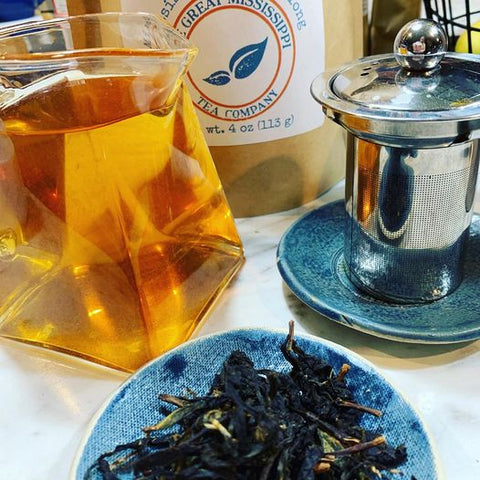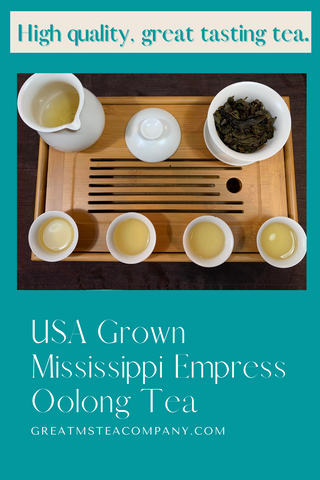Oolong tea production in the United States was relatively limited compared to other tea varieties like black, green, and herbal teas. Oolong tea has traditionally originated in China and Taiwan, where it is still predominantly grown and processed. However, we have worked to create our own process to bring Oolong tea closer to home in the US.

What is an Oolong tea?
Oolong tea stands out from other types of tea, such as green tea, black tea, and white tea, due to its unique processing method, which involves partial oxidation of the tea leaves. This oxidation level sets oolong tea apart and contributes to its distinct characteristics:
-
Oxidation Level: Oolong tea is partially oxidized, meaning that the tea leaves undergo a controlled amount of oxidation after they are harvested. The oxidation process can range from around 20% to 80%, depending on the desired style and flavor profile of the tea. This partial oxidation is what distinguishes oolong from green tea (unoxidized) and black tea (fully oxidized).
-
Flavor Profile: Oolong tea's flavor can be incredibly diverse, spanning a broad range from fresh and floral to rich and toasty, depending on the oxidation level. The unique processing allows oolong tea to offer a complex and layered taste profile with varying notes of floral, fruity, sweet, and sometimes even creamy or buttery qualities.
-
Aroma: The partial oxidation of oolong tea leaves contributes to a delicate and pleasant aroma, which is often described as floral and fruity.
-
Processing Techniques: The production of oolong tea involves multiple steps, including withering, rolling, oxidation, and firing or baking. The degree and timing of each step are crucial in achieving the desired flavor and aroma profile.
-
Rebrewability: Oolong tea is known for its ability to be brewed multiple times, revealing different nuances with each infusion. This characteristic makes it a favorite among tea enthusiasts who enjoy exploring the evolution of flavors in a single batch of leaves.
-
Caffeine Content: Oolong tea typically contains moderate levels of caffeine, falling between green tea (lower caffeine) and black tea (higher caffeine). This makes it a suitable option for those looking for a middle ground in terms of caffeine content.
-
Health Benefits: Like other types of tea, oolong tea is rich in antioxidants, which can have various health benefits. Some studies suggest that oolong tea may support metabolism, weight management, and cardiovascular health, although further research is needed to confirm these effects. More research is needed to support this.
Overall, oolong tea's unique combination of partial oxidation, diverse flavors, and distinct processing techniques make it an intriguing and enjoyable tea.

What is the flavor of an Oolong tea?
This tea has more of a cooling effect. Many say it has a light floral flavor. It is a tea that falls between green tea and black tea in terms of oxidation levels. The oxidation process can range from partially oxidized (closer to green tea) to heavily oxidized (closer to black tea), resulting in a wide variety of flavors and aromas.
The taste of oolong tea can be quite diverse, but some general characteristics include:
-
Floral: Oolong teas often have a delicate and pleasant floral aroma, which can vary depending on the specific oolong and its origin.
-
Fruity: Many oolong teas have fruity notes, which might remind you of peaches, apricots, or citrus fruits.
-
Sweet: Oolongs can have a natural sweetness, especially the less oxidized ones, which is a result of the tea leaves' natural sugars being partially retained during processing.
-
Creamy or Butter: Some oolong teas, particularly the lightly oxidized ones, have a creamy or buttery mouthfeel.
-
Earthy or Toasty: More heavily oxidized oolongs might exhibit a toasty or earthy flavor, similar to roasted nuts or grains.
-
Subtle Astringency: Oolong teas can have a slight astringent quality, which is a pleasant, mouth-drying sensation that balances the sweetness and richness of the tea.
The flavor profile of oolong teas can vary widely depending on factors such as the tea plant cultivar, growing region, climate, processing techniques, and brewing method. Each oolong tea can offer a unique experience, making it a favorite among tea enthusiasts who appreciate its complexity and depth of flavors. Our Oolong's just like all of our teas will have their own distinct Mississippi flavor.
How is our process different?
We have modernized the process to make it possible to process this great tasting tea right from Brookhaven, Mississippi. On our YouTube channel we show you more about making Oolong tea.
Make sure to SUBSCRIBE to the channel to see more content from us, on tea!
Is there a good way to make an Oolong tea?
For any of the teas it is important to make the tea correctly. This is to prevent the tea from getting a bitter taste. For Mississippi Empress Oolong you want to heat the tea to around 195 degrees for 3 minutes. If you cannot get an exact temperature we suggest bringing your water to a boil and letting it rest for 5 minutes. For more on all of our brew times visit here.

Can you cold brew Oolong tea?
It can also be done as a cold tea. It does take longer though. Cold brewing does not allow the bitterness to come through. Cold brewing should sit for at least an hour and up to 6 hours for the best result. We also now offer cold brewing tumblers in our store.
What types of Oolong tea do we offer?
We offer three types of a Oolong tea.
Mississippi Belle Oolong - This early season Oolong is a lightly oxidized oolong using older leaves to give it a rich mouth feel and a floral aroma. It is similar to a tie guan yin.

13 Moons Oolong - 13 Moons was developed with world renowned tea processor, Beverly Wainwright and has a beautiful roasted flavor. This tea won gold in Golden Leaf Awards. This was a Limited Edition tea but there are hopes that it may hot shelves again.
Mississippi Empress Oolong - This tea is usually available later in the tea season. This tea has flavor notes of floral (jasmine and lilac), sweet green (watercress or green beans), and mineral with a buttery after taste.
Want to keep reading?
Learn about how we make our Black Tea in the USA? Read here.
Learn about the surprising history of tea in small town Brookhaven, Mississippi. Read here.



Leave a comment